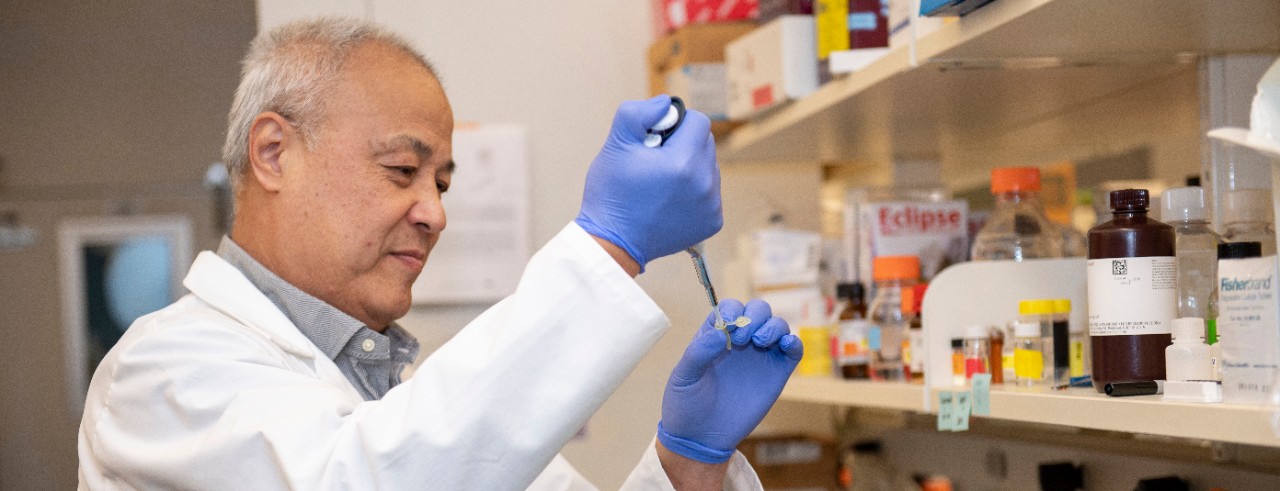
Nanosized, with huge potential
UC researcher continues work on a therapy that nudges the immune system to fight pancreatic cancer
Xiaoyang Qi is making a big difference by thinking small — nanosized, in fact.
Since the early 2000s, Qi, PhD, a professor in the Division of Hematology Oncology at the UC College of Medicine, has been tweaking his discovery, a treatment called SapC-DOPS, to address various types of cancers. It is now being studied in clinical trials for brain cancers.

Xiaoyang Qi received a $500,000 research grant from the Pancreatic Cancer Action Network. Photo/Colleen Kelley/UC Creative + Brand
The combination therapy — a cell protein (SapC) and a phospholipid or a lipid that is a component of cell membranes (DOPS) — is assembled into tiny cavities, called nanovesicles, to selectively target cancer cells and deliver therapies, all while sparing other noncancerous cells and tissues.
Now, Qi has received a $500,000 Translational Research Grant from the Pancreatic Cancer Action Network (PanCAN) to study how use of his nanoparticle could nudge the body’s immune system to fight cancer.
Qi, along with UC colleague Krushna Patra, PhD, was just one of 10 national winners of a 2020 PanCAN research award. Qi and Patra were also supported by important pilot grant funding through BSI Engineering.
“An exciting area of research that has great potential for improving outcomes for pancreatic cancer patients is understanding the role of the immune system in fighting the disease,” says Qi, who is also a member of the UC Cancer Center. “In normal circumstances, the immune system plays a key role in preventing the formation and growth of tumors, but it is now well known that many cancers, including pancreatic cancer, create a contained, protected tumor microenvironment, where the cancer lives and functions. This microenvironment allows tumors to escape the normal immune surveillance system.”
With this new project, Qi and his team will target the tumor microenvironment by blocking a protein released by pancreatic tumors. This protein usually protects the microenvironment by blocking the immune response to cancer cells, allowing them to survive and spread.
“We have preliminary data showing that blocking this protein with either neutralizing antibodies or with protein-lipid nanoparticles containing an agent called SapC-DOPG completely reverses immune suppression,” he says. “Using human cancer samples, we hope to confirm that this type of nanovesicle is specific to the cancer cells for pancreatic tumors and causes little side effects. We will also use pancreatic cancer animal models to assess how much of the protein is released in relation to tumor growth.”
This is the dream we all have as researchers — to see our basic science discoveries make a difference for patients.
Xiaoyang Qi
He adds that results for this study could be very promising, as past studies have shown benefit for treating other cancers.
“The results from this preclinical study in animal models could be rapidly applied to humans because we’ve seen success in phase I clinical trials using the same therapy in patients with brain tumors and other types of cancer,” he says.
“This is the dream we all have as researchers — to see our basic science discoveries make a difference for patients. I’m excited to continue research on this treatment and delivery system and to see if and how it can benefit patients with pancreatic cancer.”
Featured image of Xiaoyang Qi in his lab by Colleen Kelley/UC Creative + Brand.
Next Lives Here
The University of Cincinnati is classified as a Research 1 institution by the Carnegie Commission and is ranked in the National Science Foundation's Top-35 public research universities. UC's graduate students and faculty investigate problems and innovate solutions with real-world impact. Next Lives Here.
Related Stories
Study finds police officers face higher long-term health risks
January 2, 2026
J.C. Barnes, a University of Cincinnati professor, is interviewed by Spectrum News about new research showing that the physical and psychological demands of law enforcement can contribute to earlier deaths.
UC College of Nursing Professor honored with AANA education excellence award
December 23, 2025
Susan Newell, assistant professor in the UC College of Nursing, is being recognized by the American Association of Nurse Anesthesiology (AANA) as one of three top educational administrators and instructors. She will receive the Clinical Instructor of the Year Award during AANA's top educator event 2026 EDGE Conference, February 4-7 in Louisville, Kentucky.
A partnership to end pancreatic cancer
December 19, 2025
Since 2010, BSI Engineering has raised more than $1.2 million for pancreatic cancer research at the University of Cincinnati Cancer Center in honor of a friend and inspiration to BSI’s founders, Bryan Speicher.
